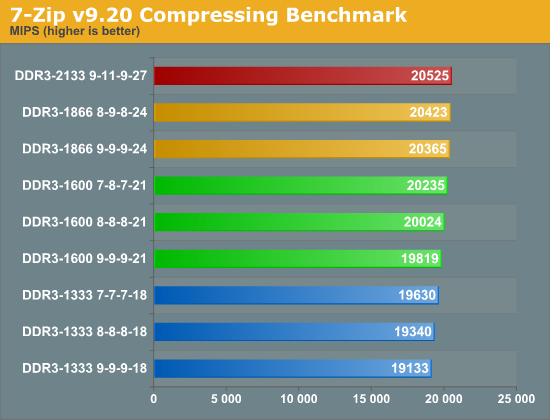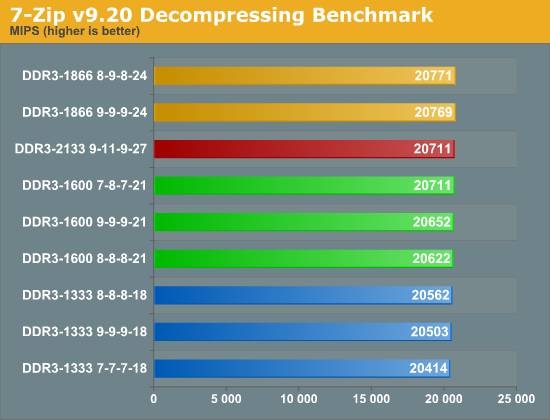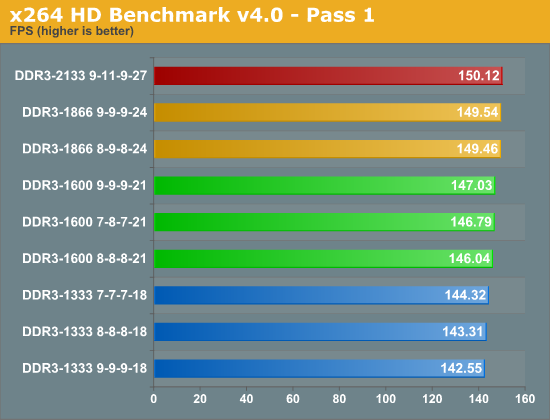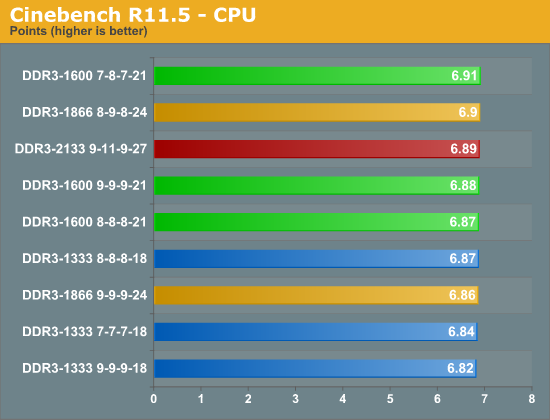Sandy Bridge Memory Scaling: Choosing the Best DDR3
by Jared Bell on July 25, 2011 1:55 AM EST7-Zip
Many people are moving over to 7-Zip for their compression/decompression needs. 7-Zip is not only free and open-source, but it also has a built in benchmark for measuring system performance using the LZMA compression/decompression method. Keep in mind that these tests are ran in memory and bypass any potential disk bottlenecks. The compression routines in particular can put a heavy load on the memory subsystem, as many MB worth of data is scanned for patterns that allow the compression to take place. In a sense, data compression is one of the best real-world tests for memory performance.


The compression test shows a linear performance increase with a ~7% variance between the fastest and slowest. If you do a fair amount of compressing, you could potentially save some time in the long run by using faster memory. This, of course, is assuming you're not bottlenecked elsewhere such as in your I/O or CPU performance. The decompression test isn’t affected by faster memory in the same way, as there’s no pattern recognition going on; it’s simply expanding the already found patterns into the original files. With less than 2% separating the range, it's unlikely to make much of a difference if you’re primarily decompressing files.
x264 HD Benchmark
The x264 HD Benchmark measures how fast your system can encode a short HD-quality video clip into a high quality H.264 video file. There are two separate passes performed and compared. Multiple passes are generally used to ensure the highest quality video output, and the first pass tends to be more I/O bound while the second pass is typically constrained by CPU performance.


While not a huge spread, we do see a difference of 5% from the fastest to the slowest in the first pass. The second pass, however, shows a less than 2% gain. If encoding is one of your systems primary tasks, it's possible that having faster memory could pay off over time, but a faster CPU will be far more beneficial.
Cinebench 11.5
The Cinebench CPU test scenario uses all of your system's processing power to render a photorealistic 3D scene containing approximately 2,000 objects and nearly 300,000 polygons. This scene makes use of various algorithms to stress all available processor cores, but how does memory speed come into play?

Apparently not much in this benchmark. We're looking at a less than 2% difference from the fastest to the slowest. It's possible that CAS latency is more important for this type of load, but due to the extremely small variance, I don't believe that statement is conclusive. Overall, even a single CPU bin would be enough to close the gap between the fastest and slowest memory we tested.










76 Comments
View All Comments
Rajinder Gill - Friday, July 29, 2011 - link
LOL!Caught with your pants down there sir.
Isaac the k - Tuesday, August 2, 2011 - link
Memory above DDR3-1333 is plentiful and cheap.Sandy Bridge benefits from the bump up to 1600.
Mobo's all can handle the higher spec'ed memory.
WHY IS INTEL SPEC'ING THE NEW I7's FOR 1333 INSTEAD OF 1600 BY DEFAULT?
I don't want to have to futz with my BIOS just to get my memory to run at STOCK timings!
Why the HELL are they crippling the basic utility of their chips??
I grant you, it isn't a major increase in performance, but why set the ceiling so low? why not set it higher and let the mobo manufacturers choose what their boards are compatible with???
shriganesh - Wednesday, August 24, 2011 - link
This article is thoughtful and very good news for mid-end to high-end system builders :)There's absolutely no need to pay extra for those faster and better memory modules!!
ryedizzel - Tuesday, September 20, 2011 - link
Thank you very much for this article. I have been memory shopping for a couple days now and debating on different memory speeds vs. latency vs. price. I wish I had the lab setup to test them all. Thanks again!James D - Monday, November 28, 2011 - link
On each speed type (1333, 1600, 1866 etc.) you used only slightly different timings! For example for speed 1333 Mhz you had:1) 7-7-7-18
2) 8-8-8-18
3) 9-9-9-18
In this case of course you won't get much different results! Don't you know that changing CL and other timings you can change tRAS timings which is the minimum number of clock cycles needed to access a certain row of data in RAM between the data request and the precharge command.
OF COURSE you won't get big difference if you didn't change tRAS! If you lower all other timings then most likely you can decrease tRAS which also will increase performance.
Please rebench all these with slightly different all types of timings. It means a lot for results.
poohbear - Saturday, December 17, 2011 - link
Thanks for running the gaming benchmarks @ 1920x1080 to show us practical results (ie there were none!). i hate it when they run these benchmarks @ 800x600 or some nonsensical low resolution to show us a difference that we really could care less about in 2011.